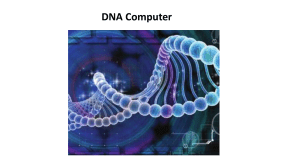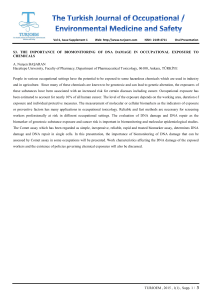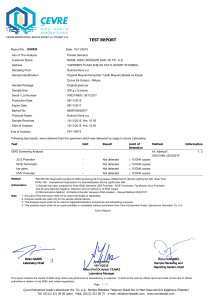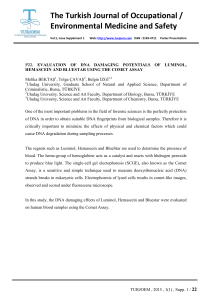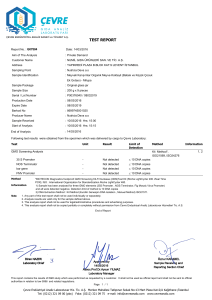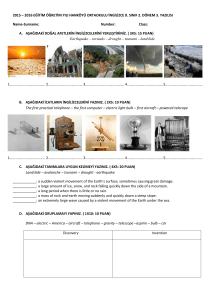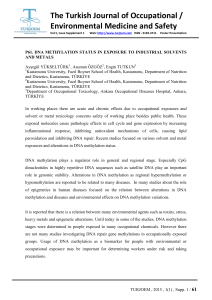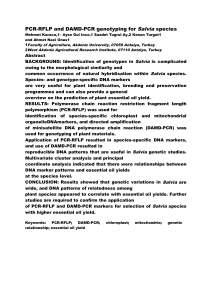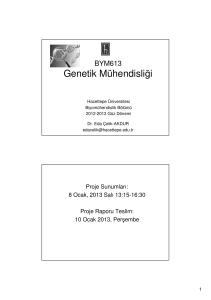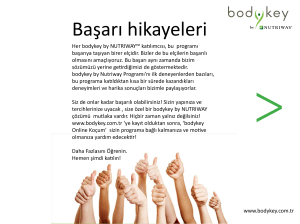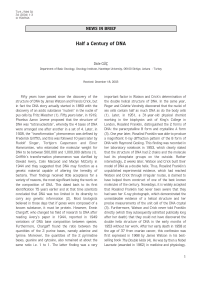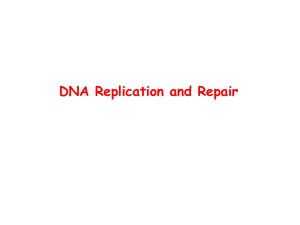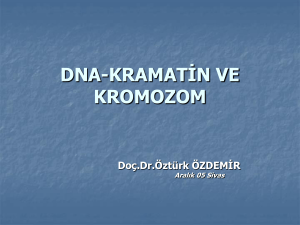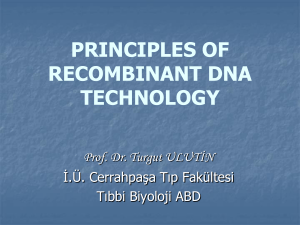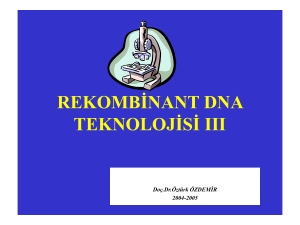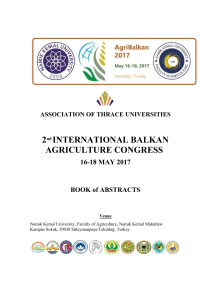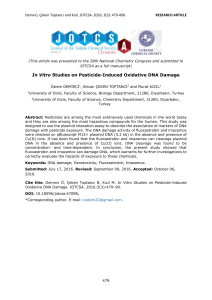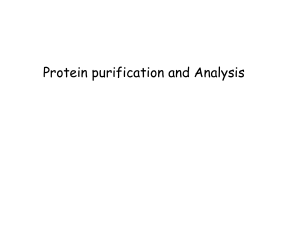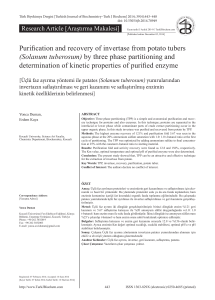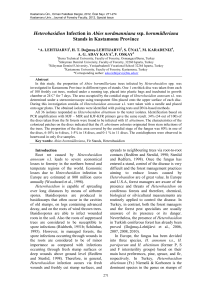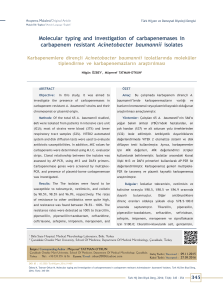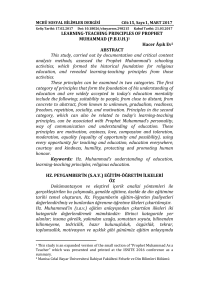YÜKSEK ETKİLİ EVRENSEL BİR YÖNTEM “TOYOPEARL HW
advertisement
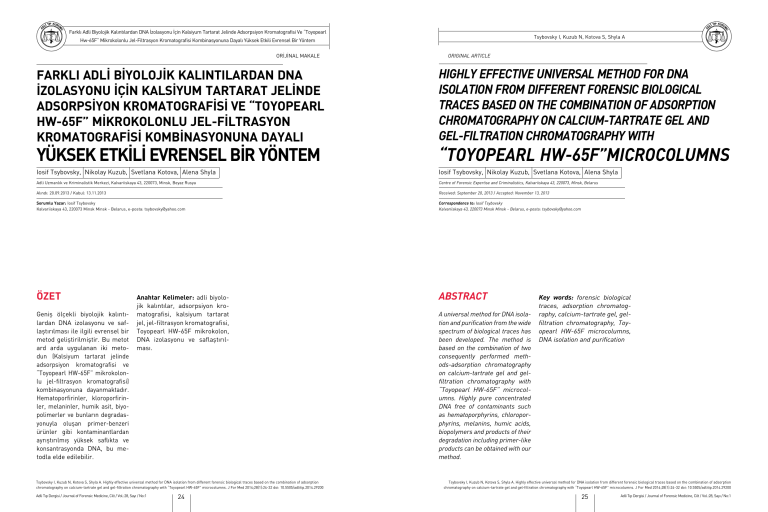
Farklı Adli Biyolojik Kalıntılardan DNA İzolasyonu İçin Kalsiyum Tartarat Jelinde Adsorpsiyon Kromatografisi Ve “Toyopearl Tsybovsky I, Kuzub N, Kotova S, Shyla A Hw-65F” Mikrokolonlu Jel-Filtrasyon Kromatografisi Kombinasyonuna Dayalı Yüksek Etkili Evrensel Bir Yöntem ORİJİNAL MAKALE ORIGINAL ARTICLE FARKLI ADLİ BİYOLOJİK KALINTILARDAN DNA İZOLASYONU İÇİN KALSİYUM TARTARAT JELİNDE ADSORPSİYON KROMATOGRAFİSİ VE “TOYOPEARL HW-65F” MİKROKOLONLU JEL-FİLTRASYON KROMATOGRAFİSİ KOMBİNASYONUNA DAYALI HIGHLY EFFECTIVE UNIVERSAL METHOD FOR DNA ISOLATION FROM DIFFERENT FORENSIC BIOLOGICAL TRACES BASED ON THE COMBINATION OF ADSORPTION CHROMATOGRAPHY ON CALCIUM-TARTRATE GEL AND GEL-FILTRATION CHROMATOGRAPHY WITH Iosif Tsybovsky, Nikolay Kuzub, Svetlana Kotova, Alena Shyla Iosif Tsybovsky, Nikolay Kuzub, Svetlana Kotova, Alena Shyla Adli Uzmanlık ve Kriminalistik Merkezi, Kalvariiskaya 43, 220073, Minsk, Beyaz Rusya Centre of Forensic Expertise and Criminalistics, Kalvariiskaya 43, 220073, Minsk, Belarus Alındı: 20.09.2013 / Kabul: 13.11.2013 Received: September 20, 2013 / Accepted: November 13, 2013 Sorumlu Yazar: Iosif Tsybovsky Kalvariiskaya 43, 220073 Minsk Minsk - Belarus, e-posta: [email protected] Correspondence to: Iosif Tsybovsky Kalvariiskaya 43, 220073 Minsk Minsk - Belarus, e-posta: [email protected] ÖZET ABSTRACT YÜKSEK ETKİLİ EVRENSEL BİR YÖNTEM Geniş ölçekli biyolojik kalıntılardan DNA izolasyonu ve saflaştırılması ile ilgili evrensel bir metod geliştirilmiştir. Bu metot ard arda uygulanan iki metodun (Kalsiyum tartarat jelinde adsorpsiyon kromatografisi ve “Toyopearl HW-65F” mikrokolonlu jel-filtrasyon kromatografisi) kombinasyonuna dayanmaktadır. Hematoporfirinler, kloroporfirinler, melaninler, humik asit, biyopolimerler ve bunların degradasyonuyla oluşan primer-benzeri ürünler gibi kontaminantlardan ayrıştırılmış yüksek saflıkta ve konsantrasyonda DNA, bu metodla elde edilebilir. Anahtar Kelimeler: adli biyolojik kalıntılar, adsorpsiyon kromatografisi, kalsiyum tartarat jel, jel-filtrasyon kromatografisi, Toyopearl HW-65F mikrokolon, DNA izolasyonu ve saflaştırılması. Tsybovsky I, Kuzub N, Kotova S, Shyla A. Highly effective universal method for DNA isolation from different forensic biological traces based on the combination of adsorption chromatography on calcium-tartrate gel and gel-filtration chromatography with “Toyopearl HW-65F” microcolumns. J For Med 2014;28(1):24-32 doi: 10.5505/adlitip.2014.29200 Adli Tıp Dergisi / Journal of Forensic Medicine, Cilt / Vol.:28, Sayı / No:1 24 “TOYOPEARL HW-65F”MICROCOLUMNS A universal method for DNA isolation and purification from the wide spectrum of biological traces has been developed. The method is based on the combination of two consequently performed methods-adsorption chromatography on calcium-tartrate gel and gelfiltration chromatography with “Toyopearl HW-65F” microcolumns. Highly pure concentrated DNA free of contaminants such as hematoporphyrins, chloroporphyrins, melanins, humic acids, biopolymers and products of their degradation including primer-like products can be obtained with our method. Key words: forensic biological traces, adsorption chromatography, calcium-tartrate gel, gelfiltration chromatography, Toyopearl HW-65F microcolumns, DNA isolation and purification Tsybovsky I, Kuzub N, Kotova S, Shyla A. Highly effective universal method for DNA isolation from different forensic biological traces based on the combination of adsorption chromatography on calcium-tartrate gel and gel-filtration chromatography with “Toyopearl HW-65F” microcolumns. J For Med 2014;28(1):24-32 doi: 10.5505/adlitip.2014.29200 25 Adli Tıp Dergisi / Journal of Forensic Medicine, Cilt / Vol.:28, Sayı / No:1 Farklı Adli Biyolojik Kalıntılardan DNA İzolasyonu İçin Kalsiyum Tartarat Jelinde Adsorpsiyon Kromatografisi Ve “Toyopearl Tsybovsky I, Kuzub N, Kotova S, Shyla A Hw-65F” Mikrokolonlu Jel-Filtrasyon Kromatografisi Kombinasyonuna Dayalı Yüksek Etkili Evrensel Bir Yöntem INTRODUCTION DNA isolation is an important step in forensic DNA analysis determining the success of a criminal investigation. Incorrectly chosen method of DNA analysis or mistakes done during DNA isolation step can lead either to DNA loss or to getting a poor quality DNA which can not be used for downstream applications. Majority of biological traces as objects for criminal identification can be found on trace carries in small amounts. Moreover biological traces are a heterogeneous group of samples: they can have different origin, contain different impurities and have different degree of degradation. During DNA isolation from a biological trace it is necessary to perform simultaneous concentration and purification of DNA from the whole spectrum of different chemical and biological substances: - chemical components (dyes of clothing, household and soil layers, lubricants) There is a number of numerous commercial kits from Qiagen, Promega and Life Technologies corporations for DNA isolation and purification which differ on their physicochemical principles, final efficacy and specificity. It is necessary constantly have different commercial kits for DNA isolation and purification to be able to solve the full spectrum of tasks which may occur in a forensic laboratory. It leads not only to the increase of financial expenses but also to the necessity to have constant and stable supply with different kits for DNA isolation and purification that it is not always possible. Up to now multistep methods combining steps of proteolytic degradation during cell lysis, DNA purification and concentration are the most effective and universal methods for DNA isolation from a wide range of sources. Digestion of cells from any biological material by proteolytic enzymes in the presence of an anionic detergent such as sodium dodecyl sulfate (SDS) leads to the com- plete release of total nuclear and mitochondrial DNA. At the final step of proteolytic lysis products of protein and other biopolymers degradation are removed from nucleic acids by adding either high concentration of salt or phenol and chloroform. Then DNA is precipitated with isopropanol or ethanol and purified. DNA extraction with organic solvents such as phenol and chloroform is still belong to the most effective method of DNA isolation that allow not only increase the degree of purity of nucleic acids but also suppress the activity of nucleases and consequently decrease DNA losses (1). The method we propose is widely used for forensic DNA analysis in the Centre of Forensic Expertise and Criminalistics, Ministry of Justice of the Republic of Belarus, Minsk, Belarus for 15 years. Our method allows to work with all kinds of biological traces to reach the maximum degree of DNA purification and to control amount of primer-like products of DNA degradation. Besides the method is relatively cheap, as one can eas- - cell biopolymers (RNA, proteins, lipids, polysaccharides) and products of their degradation - sparingly solved derivatives such as cell components and products of their degradation (hematoporphyrins, chloroporphyrins, melanins, waxlike substances and humic acids) - products of DNA degradation (single-stranded and doublestranded DNA fragments). Figure 1: The order of Toyopearl HW-65F microcolumns preparation Adli Tıp Dergisi / Journal of Forensic Medicine, Cilt / Vol.:28, Sayı / No:1 26 ily make calcium-tartrate gel (CTG) at the laboratory and it is enough to use only 0.3 ml CTG per sample. We got a patent for this method BY 11054 CI 2008.08.30 “Method of DNA isolation from a contaminated biological trace”. The method was approved for use in all organizations involved in forensic expertise in the Republic of Belarus. The method is based on the selective binding of DNA isolated from a biological trace with the surface of the adsorbent CTG with the following elution of DNA by consequent washing of the adsorbent with solutions of phosphate salts. Then the DNA solution can be purified from low molecular weight contaminants (salts, detergents, dyes, hematoporphyrins, products of different biopolymers degradation, etc) with gel-filtration on the columns with “Toyopearl HW-65F” (or “Toyopearl HW-60F”). Steps of adsorption chromatography and gel-filtration can be either combined or used separately. and short single-stranded DNA can be easily removed by washing the adsorbent with 0.1-0.2 M potassium phosphate buffer. Uncharged molecules do not interact with the adsorbent and are removed during adsorption of DNA to the adsorbent. Double-stranded DNA is eluted by washing the adsorbent with 0.20.25 M potassium phosphate buffer. Taking in the consideration high binding capacity (up to 1 µg of DNA per 1 mg of gel) and low nonspecific adsorption of CTG adsorption chromatography on CTG lets to isolate DNA from any solution and to concentrate it into a small volume; effectively remove from DNA solution polysaccharides, proteins, RNA, single-stranded DNA and other substances which can inhibit PCR reaction. During adsorption chromatography on CTG high purity separation of DNA solution components and purification of DNA can be done either in the liquid phase (adsorption batch chromatography) or with use of microcolumns. Adsorption batch chromatography on CTG Adsorption batch chromatography on CTG can be used when you work with objects containing a lot of biological material: samples and spots of blood, saliva, semen, tissue fragments, etc. The procedure does not take longer than 1 hour and can be stopped at any stage for 12-24 hours. For DNA purification with Adsorption chromatography on calcium-tartrate gel Calcium-tartrate gel (CTG) consists of spherical particles of complex calcium-tartrate-phosphate salt. It can be prepared at the laboratory by mixing sodium potassium tartrate and calcium chloride with following treatment with potassium dihydrogen phosphate (KH2PO4) at 80-100°C and pH 8.59.0 (2). CTG effectively adsorbs negatively charged biopolymers. However, adsorbed proteins, RNA Figure 2: DNA purification by gel-filtration chromatography using Toyopearl HW-65F microcolumns. Firstly TE-4 buffer is added to wash the microcolumn with Toyopearl HW-65F resin (Figure 2.1). Then the colored DNA sample (e.g. DNA sample isolated from blood) is applied to the microcolumn (Figures 2.2-2.3). DNA sample migrates through the microcolumn (Figure 2.4) and is eluted with TE-4 buffer (Figures 2.5-2.6). All impurities (brown color) are stucked inside the microcolumn and highly purified high-molecular weight DNA sample colored with blue dextran (only for demonstration purpose) is collected to a microcentrifuge tube (Figures 2.5-2.6). 27 Adli Tıp Dergisi / Journal of Forensic Medicine, Cilt / Vol.:28, Sayı / No:1 Farklı Adli Biyolojik Kalıntılardan DNA İzolasyonu İçin Kalsiyum Tartarat Jelinde Adsorpsiyon Kromatografisi Ve “Toyopearl Tsybovsky I, Kuzub N, Kotova S, Shyla A Hw-65F” Mikrokolonlu Jel-Filtrasyon Kromatografisi Kombinasyonuna Dayalı Yüksek Etkili Evrensel Bir Yöntem adsorption batch chromatography on CTG 60 µl of 50-60% CTG suspension per DNA sample was added in a 1.5 ml microcentrifuge tube. Then DNA samples were added to the tubes containing adsorbent and thoroughly mixed for 12-24 h at room temperature or for 10-15 min at 37°C. Samples were centrifuged at 2000-10000 rpm for 1 min, supernatant was decanted. 300-500 µl of 0.1 M potassium phosphate buffer, pH 7.4, was added to the pellet of the adsorbent. Samples were thoroughly mixed and centrifuged at 2000-10000 rpm for 1 min, supernatant was decanted. Then 50 µl of 0.25 M potassium phosphate buffer, pH 7.4, was added to the pellet of the adsorbent. Samples were thoroughly mixed and incubated either at room temperature or at 37°C for 5-10 min. Samples were centrifuged and supernatant was transferred to new microcentrifuge tubes. Supernatant was a concentrated DNA solution in 0.25 M potassium phosphate buffer which can be used for further purification. Depending on the source DNA solution can be colored. in a microcolumn. The procedure of microcolumn preparation will be described below (in the paragraph “preparation of microcolumns”). 200-300 µl of aqueous DNA solution previously purified with phenol and chloroform was applied to the microcolumn. Usually up to 0.5-1.5 ml of DNA solution can be purified with use of one microcolumn. After binding of DNA with the adsorbent the microcolumn was washed with 200 µl of 0.1 M potassium phosphate buffer, pH 7.4. Flow-through containing fragments of biopolymers, dyes, single-stranded DNA was discarded. Then 30-45 µl of 0.25 M potassium phosphate buffer, pH 7.4, was added to the mi- crocolumn and flow-through was collected in a new tube for further purification. The flow-through was a concentrated DNA sample in 0.25 M potassium phosphate buffer, pH 7.4, which might contain residues of substances such as melanins, hematoporphyrins, dyes of clothing, short DNA fragments. Gel-filtration chromatography with Toyopearl microcolumns DNA purification on microcolumns filled with Toyopearl HW-type resin is an original step of the method we propose. Toyopearl HW-type resins Preparation of Toyopearl HW-65F microcolumns Microcolumn adsorption chromatography on CTG Microcolumn adsorption chromatography is used when you handle such samples as single hairs, samples of fat, sweat, blood samples on washed clothing. Although this method takes from one to three hours it provides maximum degree of DNA concentration and purification from different solutions. 100-150 µl of CTG was added are hydrophilic macroporous methacrylic resins which are stable to organic solvents, acids, alkalis and characterized with hydrodynamic, mechanical, salt and thermal stability (3). Toyopearl HW-65F (P/N 07465, Tosoh Bioscience, Germany) resin with exclusion limit 5000000 Da was used in our method. Toyopearl size exclusion resins similar to sephadex and other resins separate molecules in an aqueous mobile phase according to their physical size in solution as they pass through a porous structure and simultaneously adsorb hydrophobic aromatic compounds, phenolic and polyphenolic derivates which make complexes with DNA (dyes, melanins, hematoporphyrins, etc). Besides, gel-filtration on Toyopearl resin lets to separate high molecular weight DNA from low molecular weight fragments of degraded DNA with size up to 70 base pairs. Figure 3: Electrophoresis of DNA samples isolated from dry blood (lanes 1-3) and high molecular weight DNA standard (lanes 4-6) in 0.8 % agarose gel. DNA standard was isolated from dry human blood and loaded in different concentrations: 0.5 µg/ml (lane 4), 1 µg/ml (lane 5), 5 µg/ml (lane 6). Concentration and purification of DNA samples was performed using adsorption chromatography on calcium tartrate gel (lanes 1a, 2a, 3a) followed by gel filtration on Toyopearl HW-65F microcolumns (lanes 1b, 2b, 3b). Adli Tıp Dergisi / Journal of Forensic Medicine, Cilt / Vol.:28, Sayı / No:1 28 For preparation of microcolumns filled with Toyopearl HW-65F resin tips for 20-200 µl were used (Figure 1). A small pierce of viscose wool or fiberglass (ordinary cotton can also be used) was placed in the tip with forceps (Figure 1.1). It is necessary to firm the viscose wool to make a filter with 2 or 3 mm height (Figure 1.2). The filter should not be too firm because it can considerably decrease the flow rate of the solution through the microcolumn. Prepared microcolumns with filters can be preliminary sterilized with UV-light for 20-30 min. Microcol- umns were stored in sterile boxes for tips. The adsorbent was applied to the microcolumn just before use. Before filling microcolumns with the adsorbent 300 µl of TE-4 buffer (10 mM Tris-HCl, 0.1 mM EDTA, 0.02% NaN3, pH 8.0) was added to the microcolumn and the level of liquid was marked (Figures 1.2, 1.3). The microcolumn with buffer was left for 1-2 min until TE-4 buffer flowed through the filter. 350-400 µl of Toyopearl resin was added to the microcolumn to get 280-300 µl adsorbent volume (Figures 1.4-1.7). The upper border of the adsorbent must correspond to the previously made label on the microcolumn. It is recommended to use 50-60% Toyopearl HW-65F resin suspension. The adsorbent was washed twice with 150-200 µl of TE-4 buffer and microcolumns were ready for use. Prepared microcolumns can be stored at room temperature during a working day. It is only necessary to add from time to time TE-4 buffer to wet the adsorbent. DNA purification on Toyopearl HW-65F microcolumns Before use microcolumns were washed twice with 150-200 µl of TE-4 buffer (Figure 2.1). Then 3540 µl of DNA sample purified with adsorption chromatography on CTG (DNA sample can be preliminary purified with any other method) was added to the microcolumn (Figures 2.2-2.3). The flow-through was discarded (Figure 2.4). The volume of DNA sample can not exceed 20% of the total volume of the Toyopearl HW-65F resin in the microcolumn. To effectively remove low-molecular weight impurities the volume of DNA sample should be not more than 30-35 µl. After the DNA sample had passed through the microcolumn 60-65 µl of TE-4 buffer was added. It is important to note that the total volume of DNA sample and TE-4 buffer used for the following washing of the microcolumn must be equal to 100 µl: 35-40 µl of DNA sample plus 60-65 µl of TE-4 buffer. Table 1: Characteristics of DNA samples obtained from different biological traces. DNA concentraion (µg/ml) Ratio A260/280 Buccal swabs 9.9-16.4 1.63-2.00 Dry blood samples 5.8-7.2 1.92-2.00 Hyponychial content 3.6 ≥2 Blood spots on clothing 2-7 1.68-1.86 Washouts from a condom 7.9 41.5 1.97-2.00 Post-coital samples 107-300 1.55-1.86 Biological traces 29 Adli Tıp Dergisi / Journal of Forensic Medicine, Cilt / Vol.:28, Sayı / No:1 Farklı Adli Biyolojik Kalıntılardan DNA İzolasyonu İçin Kalsiyum Tartarat Jelinde Adsorpsiyon Kromatografisi Ve “Toyopearl Tsybovsky I, Kuzub N, Kotova S, Shyla A Hw-65F” Mikrokolonlu Jel-Filtrasyon Kromatografisi Kombinasyonuna Dayalı Yüksek Etkili Evrensel Bir Yöntem After adding TE-4 buffer the flowthrough was discarded. Then the microcolumn was placed in a clean 1.5 microcentrifuge tube. 35-40 µl of TE-4 buffer, the volume equal to the volume of the DNA sample applied to the microcolumn, was added to the microcolumn (Figure 2.5). The flow-through, colorless, highly purified DNA in TE-4 buffer, was collected in the 1.5 ml microcentrifuge tube (Figure 2.6). For new batches of CTG gel and Toyopearl HW-65F resin it is recommended in preliminary experiments to determine the initial elution volume of high molecular weight DNA by electrophoresis of collected fractions in agarose gel. It helps to determine more precisely the volume of applied buffers used for chromatography on microcolumns. Recommended variants of DNA sample preparation DNA isolation from single hairs, samples of fat, sweat, saliva and other microobjects which do not contain considerable amounts of proteins and colored products For DNA isolation from these samples desalting proteins from cell lysates without following use of organic solvents such as phenol and chloroform is recommended to do. For example, sodium perchlorate can be used for this purpose. In case if the lysate is slightly colored for effective purification of the lysate from proteolysis products 1/10 the volume of 10 M sodium perchlorate (final concentration of the salt is 1.0 M) can be added to the lysate. The sample is mixed and left at 4° C for 10-15 min. At these conditions proteolysis products form with SDS (a component of the lysis buffer) a white flaky pellet which can be easily removed by centrifugation of the sample at 5000 rpm for 5 min. DNA is concentrated from the supernatant and purified on a microcolumn packed with CTG with further purification on Toyopearl HW-65F resin. DNA isolation from samples and spots of blood, saliva, semen, tissue fragments and other objects containing considerable amount of biological material If the lysate has an intensive color it is recommended to perform DNA isolation using organic solvents with sodium perchlorate which causes overturn of phases. This approach compared to the classical method of DNA isolation according to Maniatis (4) lets significantly shorten the duration of DNA isolation and to perform DNA isolation in one tube. For DNA isolation from above mentioned objects 10 M sodium perchlorate to a final concentration of 1.0-1.2 M is added to the lysate. Then the equal volume of phenol, water saturated solution with Tris-HCl, pH 8.0, is added to the sample. The sample is vortexed and centrifuged at 5000 rpm for Adli Tıp Dergisi / Journal of Forensic Medicine, Cilt / Vol.:28, Sayı / No:1 30 3-5 min at room temperature. Upper phase containing phenol with proteolysis products is carefully removed with a pipette or a vacuum aspirator and discarded. Then equal volume of chloroformisoamyl alcohol solution (24:1) is added to lower phase containing DNA followed by further mixing and centrifugation at 5000 rpm for 3-5 min at room temperature. The upper DNA-containing aqueous phase is transferred to a new tube. Then the isolated DNA sample is concentrated and purified either using adsorption batch chromatography on CTG or with Toyopearl HW-65F microcolumns. Thus, the typical algorithm of biological trace handling for DNA isolation includes following steps: 1) Lysis of minced biological trace or wash out in lysis buffer with SDS and proteases (proteinase K with a final concentration of 0.1-0.2 mg/ml or protease Streptomyseus griseus with final concentration of 0.3-0.5 mg/ml), 2) Addition to the lysate necessary volume of sodium perchlorate and remove of products of biopolymers degradation with use of organic solvents or without them, 3) DNA concentration with use of adsorption batch or microcolumn chromatography. DNA is eluted from a microcolumn packed with CTG in a final volume 30-50 µl in 0.25 M potassium phosphate buffer, pH 7.4. DNA should be further purified with gel-filtration chromatography. Gel-filtration chromatography with Toyopearl HW-65F microcolumns can be used without preliminary DNA concentration and purification on CTG. After purification on Toyopearl HW-65F microcolumns DNA is eluted in a final volume 35-40 µl in TE-4 buffer. DNA as it decreases the possibility of artifact formation during PCR reaction. Typical quantitative and qualitative characteristics of DNA isolated using above described protocol are indicated in Figure 3 and in Table 1. Analysis of qualitatitive characteristics of DNA isolated from real forensic objects shows the presence of considerable amount of degraded DNA in the samples. The smear is visible in the gel lanes 1a, 2a, 3a (Figure 3). Purification of DNA on Toyopearl HW-65F microcolumns allows to remove low-molecular weight fragments from DNA samples. The results of measurements of qualitative and quantitative characteristics of DNA isolated from different biological traces are shown in the Table 1. As one can see from the Table 1 samples obtained using the method we propose are concentrated and highly pure DNA samples. In summary, the main advantage of our method is the possibility to use it for DNA isolation from all types of biological traces. Moreover DNA can be purified from different contaminants and low-molecular weight primer-like DNA fragments using our method. Removal of primer-like DNA fragments broadens the possibilities of an expert at work with degraded 31 Adli Tıp Dergisi / Journal of Forensic Medicine, Cilt / Vol.:28, Sayı / No:1 Farklı Adli Biyolojik Kalıntılardan DNA İzolasyonu İçin Kalsiyum Tartarat Jelinde Adsorpsiyon Kromatografisi Ve “Toyopearl Hw-65F” Mikrokolonlu Jel-Filtrasyon Kromatografisi Kombinasyonuna Dayalı Yüksek Etkili Evrensel Bir Yöntem REFERENCES 1. Graham DE. The isolation of high molecular weight DNA from whole organisms or large tissue masses. Anal Biochem 1978;85(2):609– 13. 2. Akhrem A, Drozhdenyuk AP. Calcium tartrate gel. Anal Biochem 1989;179(1):86-9. 3. Toyopearl Instruction Manual. Tosoh Bioscience GMBH Germany 15 p Available at: http://www.separations.eu.tosohbioscience. com/NR/rdonlyres/DD2316A4-7228-420B908A-35E724C3369F/0/M09P18A_TIM.pdf. Cited: September, 01, 2013. 4. Maniatis T, Fritsch EF and Sambrook J. Molecular Cloning: A Laboratory Manual. New York: Cold Spring Harbor Laboratory Press, 1982. Adli Tıp Dergisi / Journal of Forensic Medicine, Cilt / Vol.:28, Sayı / No:1 32 Adli Tıp Dergisi / Journal of Forensic Medicine, Cilt / Vol.:28, Sayı / No:1
